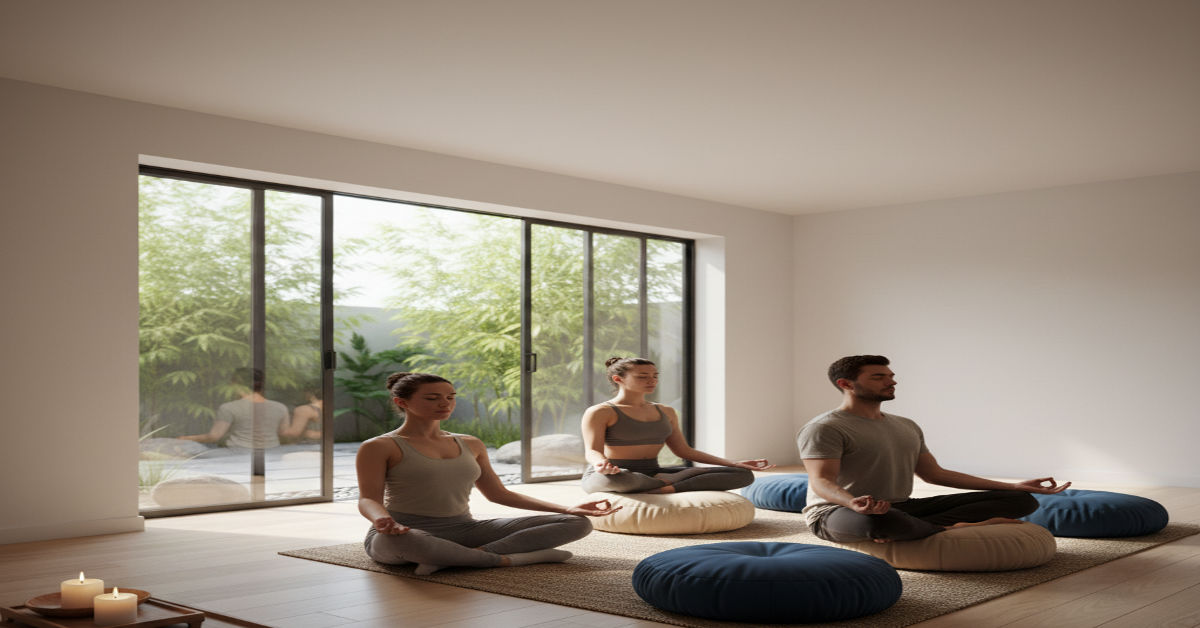In today’s fast-moving world, finding a calm space can feel impossible. If you’re typing “meditation classes near me” right now, you’re likely searching for more than just a place — you’re looking for peace, focus, and balance in your daily life. This guide gives you everything you need to find a class that fits your goals, lifestyle and experience level. Whether you’re a total beginner or someone returning to practice, you’ll learn how to evaluate teachers, compare styles, and make meditation a consistent habit.
Meditation is no longer a niche activity. Hospitals, universities, and corporations now offer mindfulness and breathing programs because the evidence is clear — meditation reduces stress, sharpens focus, and improves overall well-being. In this guide, we’ll explore how to locate the best meditation classes nearby, understand the types available, and make informed decisions based on facts and first-hand experience.
Immediate Answer: How to Find Meditation Classes Near You
If you need a quick answer right now, open Google Maps or Apple Maps and search for “meditation classes near me.” Look for studios or wellness centers with strong ratings and recent reviews. Read what people say about the atmosphere and instructors. Many centers also post their weekly schedules, membership plans, and beginner sessions online. Once you find a few promising places, contact them to ask if they offer a free or trial class. This helps you test the teacher’s style and energy before committing.
Beyond digital maps, consider local community centers, yoga studios, and health clubs. Many gyms now include guided meditation in their wellness programs. Universities often host mindfulness sessions that are open to the public. You can also check social platforms like Meetup or Eventbrite for local meditation gatherings. The goal is to experience the energy of a live group setting before making your choice. Try two or three classes in different environments to find what feels most natural to you.
Why Choose In-Person Meditation Over Apps Alone
Apps are convenient and accessible, but they often can’t replace the depth and accountability of in-person sessions. When you join a physical class, you engage all your senses. You feel the collective calm of the group, hear the subtle tone of a teacher’s guidance, and notice how your body responds to stillness. This shared energy deepens concentration in ways that solo practice on a screen often can’t match. Teachers also offer instant feedback that helps correct posture or clarify confusing moments in your meditation.
Another major benefit is community. Humans learn through presence and support, and meditation classes create a safe environment for that. Many students find that simply showing up for others keeps them consistent. You build friendships, share experiences, and motivate each other to continue even when it feels difficult. In-person classes also let you explore advanced practices such as sound baths, group chanting, or breathwork techniques that apps rarely provide. The result is a more immersive, transformative experience that often accelerates progress.
Audience & Search Intent: Who This Guide Serves
This guide is written for people who want to discover meditation classes near them but aren’t sure where to start. You might be a professional managing stress, a student seeking focus, or someone looking for peace after burnout. No matter your background, the goal is the same — finding accessible, trustworthy meditation classes that deliver real results. The tone here is warm, informative, and experience-driven, helping you make practical decisions without confusion or pressure.
From a search intent perspective, this guide serves both local and transactional needs. Readers want to find a nearby class they can join, but they also want to understand what kind of class best fits their needs. That’s why this article goes beyond location — it helps you identify quality, style, and structure so you can confidently choose. You’ll leave not just with a list of studios but with the knowledge to evaluate them and make meditation a lasting habit.
Core Benefits of Meditation — Backed by Science
Meditation is not only a spiritual or cultural practice; it’s a scientifically backed method to enhance health and happiness. Research from major universities and the U.S. National Institutes of Health shows that regular meditation reduces anxiety, lowers blood pressure, and improves sleep quality. It helps regulate the nervous system and balances emotional responses. Studies also reveal improved memory, focus, and problem-solving skills in consistent practitioners. These benefits make meditation one of the most effective natural tools for personal growth.
Beyond the numbers, meditation builds resilience. Life’s challenges often trigger automatic stress reactions. With consistent practice, you learn to pause before reacting. This awareness gives you control over your choices and emotions. Many people report a greater sense of connection, empathy, and joy as they continue. Science now confirms what ancient traditions have taught for centuries — stillness can heal, and awareness transforms how we live.
Types & Formats of Meditation Classes You’ll Find
When searching for meditation classes near you, you’ll notice a variety of approaches. The most common include Mindfulness Meditation, Loving-Kindness Meditation, Transcendental Meditation, Zen Meditation, and Guided Visualization. Each method has its unique rhythm and focus. Mindfulness emphasizes being present with your breath and sensations. Loving-Kindness cultivates compassion for yourself and others. Transcendental Meditation uses mantras to quiet the mind, while Zen meditation focuses on seated stillness and awareness of thought.
Classes also vary in structure. Some studios offer open drop-in sessions, while others provide structured courses over several weeks. Private one-on-one coaching allows for personalized guidance, though it’s usually more expensive. Retreats are immersive experiences lasting a weekend or more, perfect for those who want to deepen their practice. Understanding these formats helps you choose the experience that suits your goals and lifestyle.
How to Evaluate a Local Class: 7 Criteria
Finding a meditation class is easy, but finding the right one requires attention. Start with the instructor’s background. A qualified teacher should have both formal training and real-life experience in their chosen tradition. Look for certifications from recognized programs such as Mindfulness-Based Stress Reduction (MBSR) or Transcendental Meditation (TM). Ask how long they’ve been teaching and whether they continue their own practice. The best teachers embody calmness rather than only talk about it.
Next, evaluate the learning environment. Visit the space before signing up if possible. A clean, quiet setting helps you relax and focus. Ask about class size, schedule flexibility, and payment options. Smaller groups allow more personal attention. Transparent pricing and clear communication build trust. Check online reviews to see how others describe the class energy. A good studio feels welcoming and grounded from the moment you walk in.
Typical Price Ranges, Schedules & What’s Fair
Meditation class prices vary by location, format, and teacher experience. In large cities, a drop-in class usually costs between $10 and $25. Structured programs such as an 8-week mindfulness course may cost $150 to $400, while private one-on-one sessions often range from $60 to $150 per hour. Smaller towns or community centers may offer affordable or donation-based options. Always ask what’s included — some centers provide mats, tea, or post-class discussions, while others charge extra for materials.
Schedules are equally diverse. Many studios hold morning sessions for those who like to start their day calmly. Evening classes are popular for stress relief after work. Weekend workshops and retreats cater to people seeking deeper immersion. The best schedule is one that aligns with your daily rhythm. Consistency matters more than frequency, so pick a class time you can realistically maintain.
Case Study: One Beginner’s Journey in a Local City
Let’s take the story of Amira, a 32-year-old marketing professional who felt constantly overwhelmed. She searched for “meditation classes near me” and visited three studios. The first had friendly teachers but little structure. The second offered a formal 6-week mindfulness program. The third was a private instructor specializing in stress management. Amira chose the second option because it gave her guidance, accountability, and affordable pricing.
After two months, she noticed real changes. Her sleep improved, her concentration at work increased, and her overall mood stabilized. She also formed friendships with classmates who encouraged her to keep going. Amira’s experience shows how the right environment can make meditation not just a habit but a lifestyle change. It also highlights that success doesn’t depend on the most expensive option — it depends on consistency and fit.
How to Search, Visit & Try Out Meditation Classes Near Me
Begin your search by using digital maps and typing “meditation classes near me.” Filter by ratings above four stars and read recent reviews to gauge authenticity. Visit studio websites and check class descriptions, instructor profiles, and schedules. You can also explore local community boards or wellness directories. Many meditation teachers host open houses or free trial days where you can experience their style before enrolling.
When you visit, pay attention to how you feel upon entering. A good studio has a peaceful atmosphere where your body instinctively relaxes. Speak with the instructor about your goals and ask what to expect in class. If they answer with patience and clarity, that’s a strong sign of professionalism. Attend a trial session, reflect afterward, and choose the place where your mind feels both calm and engaged.
Conclusion & Next Steps
Searching for meditation classes near me is the first step toward a calmer, more focused life. You now know how to evaluate options, understand different types of meditation, and identify trustworthy instructors. The benefits of consistent practice are well-documented — reduced stress, better mood, improved focus, and deeper self-awareness. The right class will feel peaceful, professional, and supportive.
Your next step is simple. Open Google Maps or your favorite wellness directory and find two or three classes near you. Visit, try a session, and trust your intuition. Meditation is less about perfection and more about presence. Once you find a place that feels right, commit for a few weeks and observe the shift in your mind and body. Peace is closer than you think — sometimes just one class away.
Common FAQs
Q1: Can beginners join meditation classes?
Yes, most studios welcome beginners. Many even design special introduction courses to help you understand the basics of posture, breathing, and attention.
Q2: How long before I notice results?
Most people feel calmer within a few sessions. Long-term benefits like improved focus and reduced anxiety usually appear after 6–8 weeks of consistent practice.
Q3: What should I bring to class?
Wear comfortable clothing and bring a bottle of water. Some people like to bring a small notebook to jot down reflections after practice.
Q4: Are meditation classes religious?
Most modern studios teach meditation in a secular way. However, some follow traditional roots like Zen or Tibetan practices. Always check the class description before enrolling.
Q5: Can I combine online apps with in-person classes?
Absolutely apps are great for daily practice, while in-person sessions provide feedback and structure. The combination keeps you balanced and consistent.







